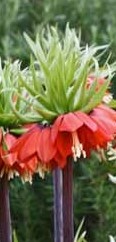 This spring blooming bulb is a member of the lily family, Liliaceae, and native to Turkey, Iraq, Iran, Afghanistan, and Pakistan. It stands three to four feet tall and has a large, dense whorl of red, orange, or yellow flowers, that hang beneath a tuft of leaves at the top of the stem. At the base of each flower petal there is a tear drop-like liquid that runs when touched. The plants have an unpleasant foxy ordor, that is said to repel mice and voles.
This spring blooming bulb is a member of the lily family, Liliaceae, and native to Turkey, Iraq, Iran, Afghanistan, and Pakistan. It stands three to four feet tall and has a large, dense whorl of red, orange, or yellow flowers, that hang beneath a tuft of leaves at the top of the stem. At the base of each flower petal there is a tear drop-like liquid that runs when touched. The plants have an unpleasant foxy ordor, that is said to repel mice and voles.
In The Winter’s Tale (act iv, sc, 4, 125) Perdita, at the sheep shearing celebration, tells the guests as she distributes flowers to them;
bold oxlips and
The crown imperial; lilies of all kinds,
The flower-de-luce being one! O, these I lack,
The crown imperial lily was a popular plant in Turkish gardens and was sent to Vienna by Jules Charles de L’Ecluse in 1576. The English botanists Gerard and Parkinson, contemporaries of Shakespeare, mention it as does George Herbert, metaphysical poet of Shakespeare’s time, and George Chapman, English poet and rival of Shakespeare.
Two legends have evolved to explain the nodding flowers and tear drop-like liquid . One story says that when a sultana accused his wife of infidelity and had her executed an imperial fritillary saw what happened, hung its head and began to cry. The second story says that imperial fritillaries were blooming near the site of the Crucifixion of Christ, hung their heads and began shedding tears. This legend may account for a second common name, tears of Mary.
The common name “crown imperial” may come from the crown-like look of the whorled flowers, especially the gold ones, from the tuft of leaves at the top of the stem that resembles a crown.
To buy crown imperial bulbs from Amaon.com click here.